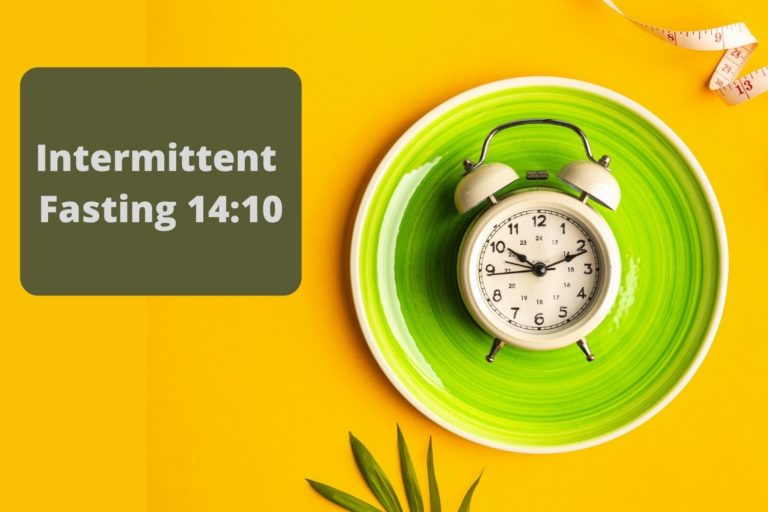What is Intermittent Fasting 14:10?
Intermittent fasting is not as complicated as some people may think. It is not eating for a certain period of time. In other words, you are omitting certain meals. Intermittent fasting 14/10 is one of the new ratios of fasting window period and feeding widow period. Therefore, for the 10-hour window period, you can eat normally. The remaining 14-hour window period is for fasting.
People on this schedule have different approaches to the 14/10 method. One common practice is eating your regular meals between 9.00 am and 7.00 pm. So, that accumulates to 10 hours of the eating window period. From 7.00 pm to the following day 9.00 am you don’t eat anything. That makes an ideal 14-hour fasting window period.
Another common approach to the one above is having an 8.00 am-6.00 pm 10-hour eating window period. Then, having a 6.00 pm to the following day 8.00 am 14-hour fasting window period. Therefore, it is entirely up to you to decide which timeline fits your schedule well.

Main Rules of the Intermittent Fasting 14/10
In several instances, people complicate these rules. They usually want to know if they can incorporate supplements during the fasting window period. Yes, you can do supplements. You can also drink water, tea, or black coffee. However, note that in a responsible fasting period, you may only drink water—nothing else. Still, I may consider adding supplements, tea, and black coffee as fasting. Drinking these beverages may not significantly break the fasting window.
The time-restricted eating of 14/10 approach may dictate what you should not drink during the fasting period of time. However, it does not limit you to eating only a certain bite of food types during the eating window. Therefore, it means that you are free to munch whatever you want. The primary condition is that it has to be within the 10-hour eating window. However, my recommendation is that you should avoid junk food or limit to minimum food consumption. Eating lots of junk food during the eating periods of time may slow down your weight loss journey.

Your usual meals may also incorporate snacks. During the 14- hour fasting period of time, the intermittent fasting 14/10 approach does not allow any calorie intake. You may therefore have to stick to water until the 14 hours are over. However, the approach permits you to drink unsweetened black coffee occasionally. Unsweetened green tea may also be a perfect alternative to solid foods.
How Intermittent Fasting 14/10 Works in weight loss
What is your body weight? Have you been experiencing a steady weight gain recently and want to start a weight loss journey? Then, you may have to consider intermittent fasting 14/10 as your primary weight-loss tool. For clarity purposes, here is how intermittent fasting 14/10 works on overweight adults.
Losing weight for overweight adults is simple and not as complicated as some may perceive. When you are on intermittent fasting, you are limiting your calorie intake. So, it may help if you incorporate a well-balanced, healthy diet. Eating healthy while on intermittent fasting doubles the chances of achieving target health benefits. When you limit your calorie intake to zero, your body has no sugars to burn for metabolic activities. The lack of glucose in the body does not mean that your body will not perform its functions.

To perform physical and brain activities, your body will enter a ketosis state. Therefore, when you are fasting, your body burns the deposited fat as a fuel source. As the body burns the deposited fat to maintain its standard energy levels, you lose weight. Also, you tend to reduce some unhealthy body fat that mainly covers body organs. Ultimately, you significantly reduce your risk of developing metabolic syndromes. Some of these metabolic syndromes include blood pressure, high sugar levels in the blood or high blood glucose, and excess weight. Also, due to decreased calorie (sugar) intake, you reduce your bad LDL cholesterol levels.
Benefits of intermittent fasting 14/10 vs. 16/8
There are several health benefits of having a 10-hour window for eating and a 14-hour window for fasting. A recent 2017 study showed that overweight adults who followed the 14-hours intermittent fasting schedule lost more weight. They lost more weight than their counterparts, who ate more calorie foods from time to time. (1).
If you use the 14/10 approach as a weight-loss tool, you stand a chance of experiencing more beneficial effects. There is more to an intermittent fasting schedule than losing weight. With that said, the beneficial effects of intermittent fasting 14 hours a day include;
· Weight loss is the primary beneficial effect of regular fasting using the 14/10 schedule.
· Fasting for 14 hours a day also helps you achieve some minor benefits in cognitive development.
· Also, the schedule improves your mood.
· To some extent, intermittent fasting 14/10 schedule also helps reduce inflammation.
· This schedule helps you progress further into 16, 18, 20, and maybe 23 hours period of fasting.
However, intermittent fasting 16/8 schedule may have more beneficial effects. It helps in the significant manifestation of the above health benefits. Additionally, The 16/8 approach may help you experience the benefits of autophagy. Unlike the 14/10 approach, the 16/8 method contributes to the recycling of old proteins. It also helps in anti-aging.
Integrating intermittent fasting 14/10 with the keto diet
Healthy eating is essential when it comes to the 14/10 intermittent fasting schedule. Let’s assume that an average person consumes breakfast, lunch, and dinner daily. Between these meals, there can also be snacks. This trend means that an average person keeps on eating Mini – meal from time to time. In that case, the individual may regularly be experiencing fatigue, memory issues, or the development of belly fat. Lack of focus and cravings are also symptoms of someone whose food intake is from time to time. Chronic diseases like diabetes and obesity may also result from eating balanced meals from time to time. Apart from that, the individual may look healthy.

The common denominator of the above case study is high insulin levels due to high blood sugar levels. The solution, in this case, is to lower the insulin levels. That’s where the ketogenic diet intervenes. When you are in the initial stages of your 14/10 intermittent fasting schedule, it would be essential to integrate the keto diet. The keto diet other than the regular diet helps reduce insulin levels. Intermittent fasting acts as a weight-loss tool that reduces your weight loss journey. All you need to do is lower your carbohydrate intake. Your food intake within the 10-hour eating window period should therefore have fewer carbohydrates and junk foods other than a normal diet. Keep in mind that all these benefits are only related to the ketogenic diet and not with any other regular or popular diet.
Conclusion
Intermittent fasting 14/10 works well with keto. Each program plays its role. Your body gets to burn the excess fat through regular fasting. Additionally, you get to reduce your blood insulin levels through the keto diet that lowers the carb. However, it is important to note something. If you are a beginner and would like to integrate keto and intermittent fasting, you may need to begin on a low tempo. For instance, start with three meals a day, without snacks. Then advance to two meals a day. Finally, proceed to one meal a day.







